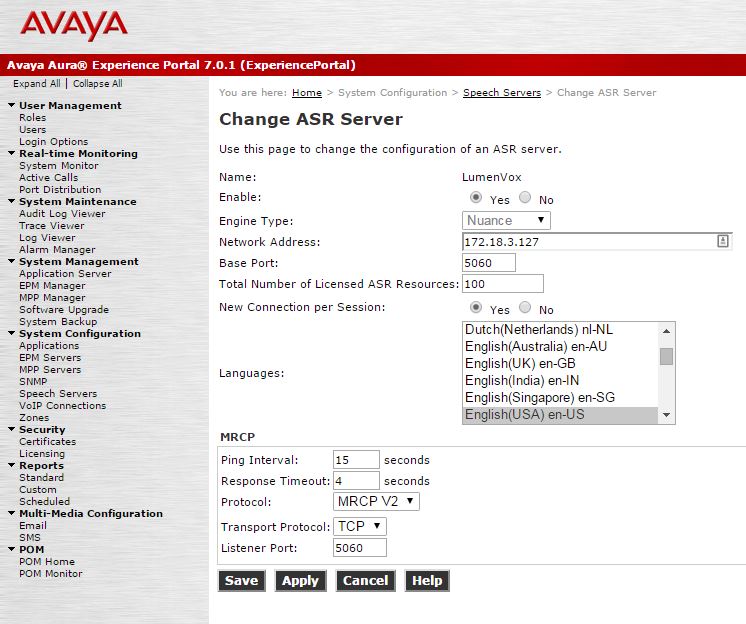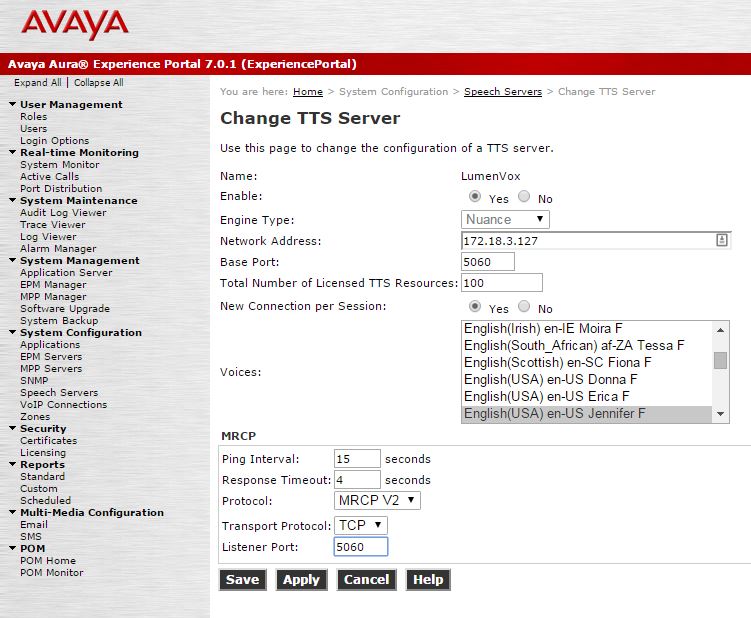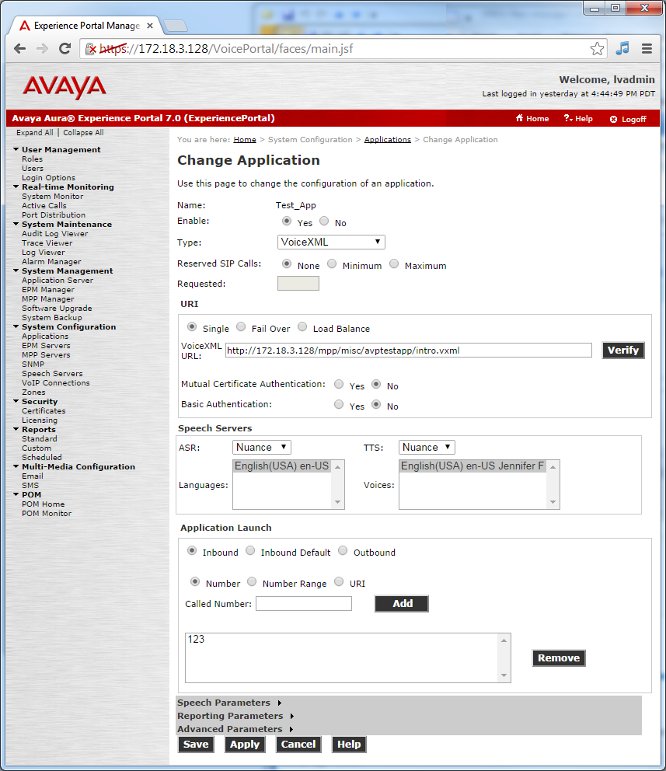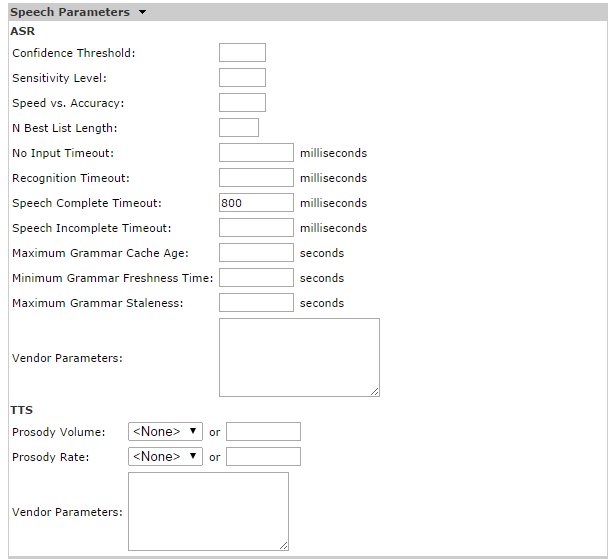Introduction
This document describes configuration notes for the LumenVox ASR and TTS servers running with the Avaya Aura Experience Portal (AAEP) version 7.0. This document was written for LumenVox 12.1.100, though it should apply for any post-10.0 release of LumenVox.
LumenVox does not support the ability to test our ASR and TTS directly from the Orchestration Designer's Application Simulator. We recommend deploying applications made from OD into AAEP to test them.
Note:
Avaya introduced a change in behavior between AAEP versions 7.0.0 and 7.0.1, which breaks ability to maintain sessions. This necessitates the use of MRCP v2 (instead of our default MRCP v1) for complete, successful communication with the LumenVox ASR and TTS. The notes immediately following this message are meant for AAEP 7.0.1 and 7.0.2. Notes for 7.0.0 are at the bottom of this page. At this time, it is unclear whether or not Avaya intends to revert their operations to support the previous behavior.
LumenVox Configuration
There are only two changes from the default configuration that must be made. These can be made either in the LumenVox Dashboard's Media Server configuration interface, or directly to the /etc/lumenvox/media_server.conf file:
- The value of mrcp_server_ip must be set to the IP address of the machine that LumenVox is installed on. This must be an IP address that the AAEP machine can reach and route traffic to. Please contact LumenVox Support for questions about configuring firewalls if they will be running.
- The value of compatibility_mode must be changed from the default 0 to 1
AAEP Configuration 7.0.1 and 7.0.2 - ASR
When adding a LumenVox ASR to the AAEP Speech Servers, the following settings should be used. The highlighted settings indicate deviations from AAEP's default values and so special care must be taken to set these correctly:
- Enabled: Yes
- Engine Type: Nuance
- Network Address: <ip of the machine running LumenVox>
- Base Port: 5060
- Total Number of Licensed ASR Resources: <number of licenses installed>
- New Connection per Session: Yes
- Languages: en-US
- Ping Interval: 15
- Response Timeout: 4
- Protocol: MRCP V2
- Transport Protocol: TCP
- Listener Port: 5060
An example of this ASR configuration can be seen in the following screenshot:

Figure 1: Sample LumenVox ASR configuration from the AAEP Speech Servers configuration manager.
AAEP 7.0.1 & 7.0.2 Configuration – TTS
When adding a LumenVox TTS to the AAEP Speech Servers, the following settings should be used. The highlighted settings indicate deviations from AAEP's default values and so special care must be taken to set these correctly:
- Enabled: Yes
- Engine Type: Nuance
- Network Address: <ip of the machine running LumenVox>
- Base Port: 5060
- Total Number of Licensed ASR Resources: <number of licenses installed>
- New Connection per Session: Yes
- Languages: en-US
- Ping Interval: 15
- Response Timeout: 4
- Protocol: MRCP V2
- Transport Protocol: TCP
- Listener Port: 5060
An example of this TTS configuration can be seen in the following screenshot:

Figure 2: Sample LumenVox ASR configuration from the AAEP Speech Servers configuration manager.
AAEP Configuration – Application
When configuring an application to make use of the LumenVox ASR and/or TTS in the AAEP configuration manager, there are a few notes to be aware of:
- Because the Engine Type parameter was set to Nuance, the ASR and TTS will show up as "Nuance" in the Speech Servers drop-down list within an application's configuration screen.
- Under Speech Parameters, be sure and set Speech Complete Timeout to a non-zero value (0 is the default). 800 ms is our recommended value. The other settings can be left blank.
- These settings apply to any version of AAEP, and are not affected by the changes introduced in AAEP 7.0.1.

Figure 3: Adding the previously-setup LumenVox ASR+TTS servers to an application. Notice how the dropdown displays "Nuance" in both cases.

Figure 4: The Speech Parameters for an application. Speech Complete Timeout must be set to a non-zero value while all other parameters can be left blank (their default).
AAEP Configuration 7.0.0 - ASR
When adding a LumenVox ASR to the AAEP Speech Servers, the following settings should be used. Note that these settings should only be used for AAEP 7.0.0. If you are using version 7.0.1, or 7.0.2, you should use the MRCP v1 settings indicated at the top of this page.
The two highlighted settings indicate deviations from AAEP's default values and so special care must be taken to set these correctly:
- Enabled: Yes
- Engine Type: Nuance
- Network Address: <ip of the machine running LumenVox>
- Base Port: 554
- Total Number of Licensed ASR Resources: <number of licenses installed>
- New Connection per Session: Yes
- Languages: en-US
- Ping Interval: 15
- Response Timeout: 4
- Protocol: MRCP V1
- RTSP URL: <ip>/media/speechrecognizer
Here is an example screenshot from AAEP for this configuration:

Figure 5: Sample LumenVox ASR configuration from the AAEP Speech Servers configuration manager.
AAEP 7.0.0 Configuration – TTS
When adding a LumenVox TTS to the AAEP Speech Servers, the following settings should be used. The highlighted settings indicate deviations from AAEP's default values and so special care must be taken to set these correctly:
- Enabled: Yes
- Engine Type: Nuance
- Network Address: <ip of the machine running LumenVox>
- Base Port: 554
- Total Number of Licensed ASR Resources: <number of licenses installed>
- New Connection per Session: Yes
- Languages: en-US
- Ping Interval: 15
- Response Timeout: 4
- Protocol: MRCP V1
- RTSP URL: <ip>/media/speechsynthesizer
Below is an example screenshot from AAEP for this TTS configuration:

Figure 6: Sample LumenVox ASR configuration from the AAEP Speech Servers configuration manager.
Testing The Integration
Configure the AAEP builtin Test App application to make use of the LumenVox ASR and TTS as shown in the previous step. Make a call into the system to test the ASR and TTS functionality.